In the 1950s, he was one of the founders of the company that revolutionised Brazilian theatre, and is probably the person who best embodies the meanings of, and the various controversies surrounding, Tropicalism. He is also arguably the most complete cannibal among all those who have been inspired by Oswald de Andrade. Known as Zé Celso, he is the centre of activity for more than a dozen employees: young directors, actors, actresses, artists, engineers, designers, journalists and architects, including his brother João Batista Martinez Corrêa and his granddaughter Beatriz Pimenta Corrêa, who together were responsible for the recent project to expand the theatre. We came here in the company of curator and writer Daniela Castro and José Lira, an architect and university professor who also worked as editor on the interview.
Domus: Tell us about what Oficina meant for Brazil in the 1960s.
José Celso Martinez Corrêa: In 1967, the performance of Oswald de Andrade's play O Rei da Vela decolonised this theatre of ours. In 1928 he wrote his Manifesto Antropófago ("Cannibal Manifesto"), re-establishing our relationship with the South- American Indian cannibals and with the Africans, who created Candomblé, samba and funk. The 1967 production turned out to be the catalyst for a full-fledged movement that sprung up spontaneously around the same period: from Glauber Rocha, who was filming Earth in a trance at the time, to Caetano Veloso, with his release of the Tropicália album, to Hélio Oiticica, who set the stage for art to come alive, complete with earth, plants and television. So that's how the Tropicália movement came into being and how Brazil freed itself entirely of all colonial ideology.
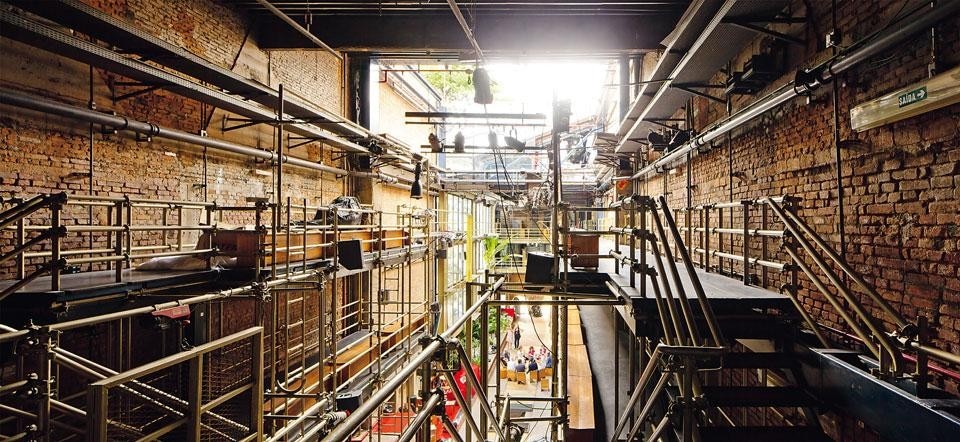
José: This is the third theatre that has been built here. The first, designed by Joaquim Guedes, had two seating areas with the stage in the middle. It took eight months to build in 1961, and was burnt down in 1966. The second project was by Flávio Império. At the time I was very interested in the theatre of Bertold Brecht, and Império designed a very pristine theatre with a revolving stage and concrete tiered seating. It took a year and a half to build, and opened in 1967 with the production of O Rei da Vela, and that was another "blaze"! Lina Bo Bardi had arrived before then, to work with me on the production of Brecht's In the Jungle of Cities. It was the period when they were tearing the neighbourhood apart building the so-called Minhocão, or "big earthworm", the Costa e Silva elevated expressway named after the dictator. Lina would bring in all the garbage she found outside, put it on stage and we'd use it for a scene. We even used the trees that had been chopped down during construction. Each act was like a round in a boxing match.
Domus: Does your relationship with Lina date back to that time?
José: I remember that I did some LSD with a friend of mine, my companion. It was good acid. We went outside and started running around the theatre when suddenly we came up against a wall and we realised that there was something else beyond it... It was a very difficult time. The police were coming and we didn't know where to run. We found ourselves in front of this huge wall. When the police raids began, we began to get worried, so I went to talk with Lina. She said: "I'm an architect! I can't go through walls! I'm not a witch! All I can do with walls is break them down." And that's how Lina came up with the idea of turning the Oficina into a kind of street running all the way up to Anhangabaú da Feliz Cidade, in the region of Vale do Anhangabaú (the district where the theatre is located and where public meetings and events are traditionally held), in Viaduto do Chá to be exact. Then she designed a very nice project in that area. She had big metal trees built and placed an overpass on top of them, so that Anhangabaú would be green again.
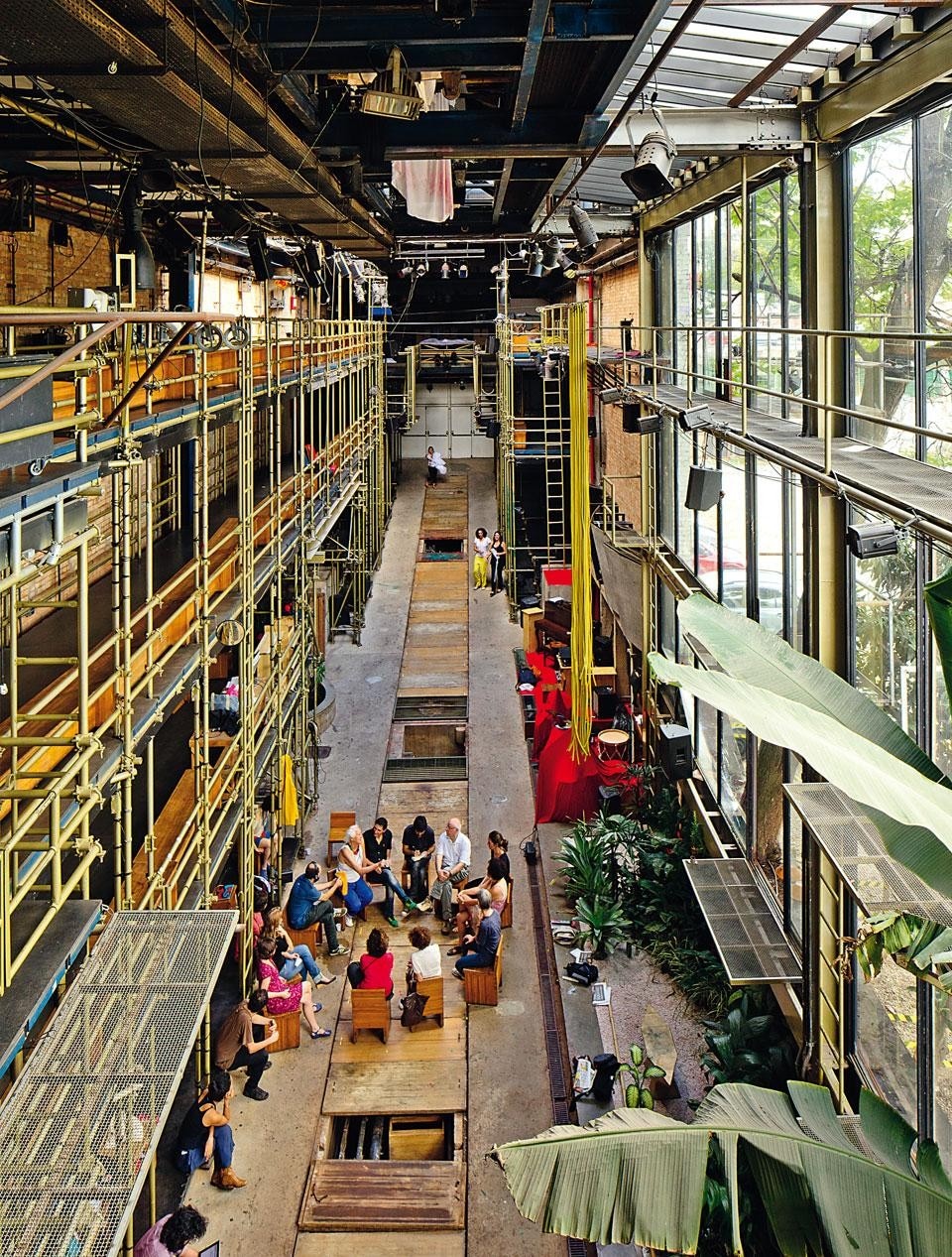
José: Lina wanted to build a space that had a bond with the earth, so we made this underground passage beneath the stage where there is a small plot of ground. She always put water and fire in the shows. We had always wanted to stage Os Sertões — Euclides da Cunha's 1902 book, which we've been making into a series of montages since 2001, with 25 hours' worth so far. Lina said: "The sertão, the backland, is here." And just like in the backlands of Candomblé, throughout Brazil there is always a sacred tree. We have ours, too. It was this tree that won the fight, because it represented our vanguard; this tree was the first thing to invade the land next door, understand?
Domus: From the War of Canudos for the destitute settlers of the Northeast to the struggles against Silvio Santos, the owner of a very important TV network.
José: Ah yes, our troubles with Silvio Santos. Thirty years spent punching holes in the walls, just like a real family feud. After the Ministry of the Environment ruled in our favour, they threw up a concrete barricade to block our access to the grounds. It has been a 30-year struggle to keep our neighbours from building first a shopping centre, which would have destroyed this entire window, and then a series of apartment towers. The surrounding area was completely developed; there even used to be two houses protected by the cultural heritage commission and an age-old synagogue. When Silvio Santos approached us, we were preparing Os Sertões.
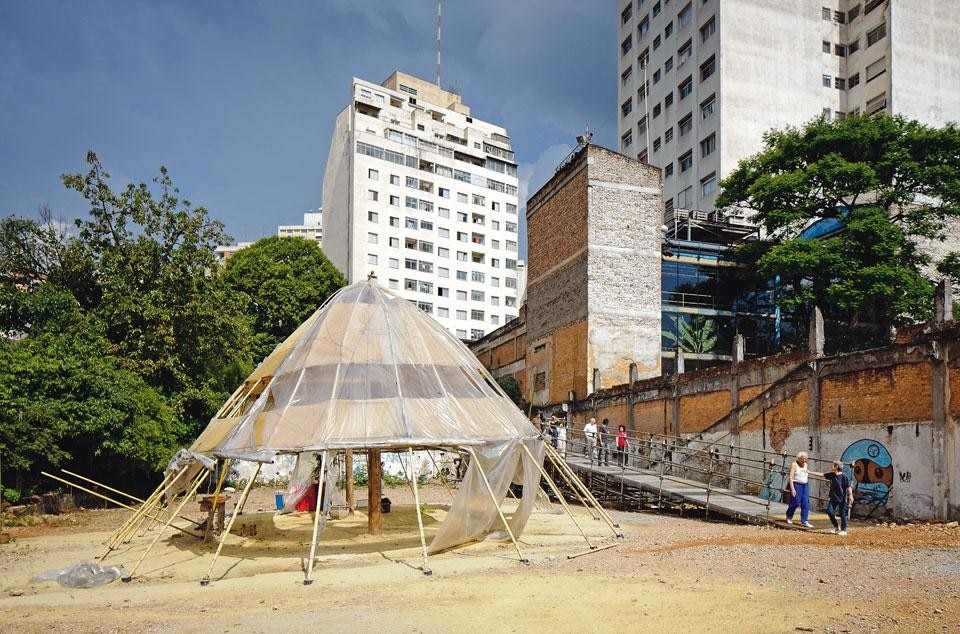
José: Fortunately Silvio Santos finally gave up. Our theatre was placed under the guardianship of IPHAN (Instituto do Patrimônio Histórico e Artístico Nacional), which also imposed the statesponsored expropriation of the surrounding land.
Actress: We were doing Dionisíacas.
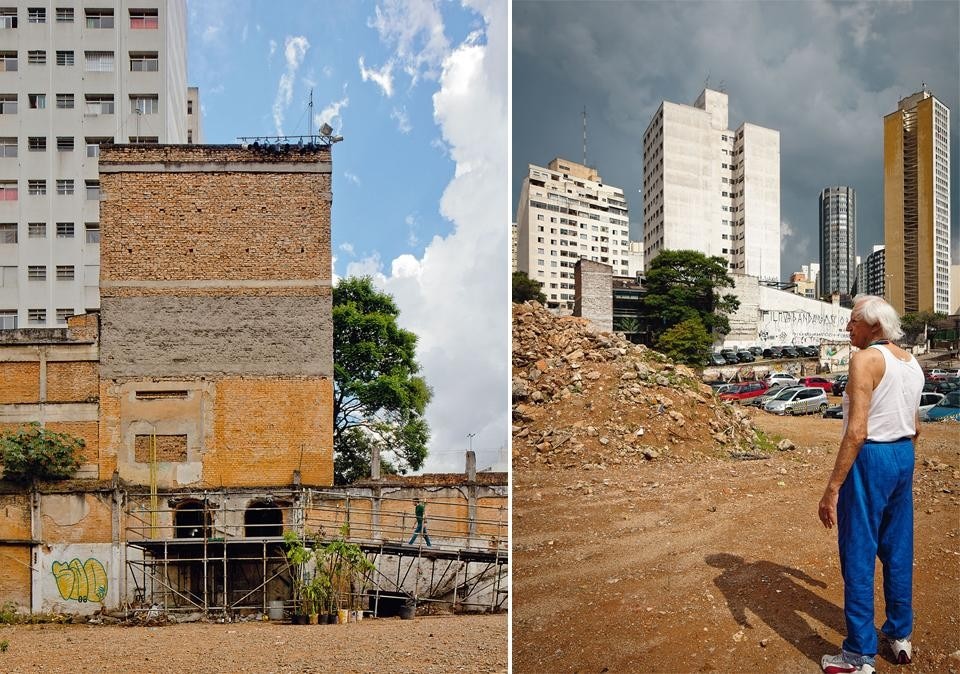
Domus: So the current struggle is different than before.
José: We're already occupying the land and we have done some shows. We asked Silvio Santos to lend us his land and he agreed, although at present we're on tour around Brazil staging everything under a huge 2,000-seat tent, performing a Japanese Noh-style drama, another play titled Cacilda about a very important Brazilian actress, as well as The Bacchae and The Banquet. We've set up a game of "snakes and ladders" and opened up a passage in the wall of the backdrop. There were some beautiful ruins out there and we staged Macumba Antropógrafa Urbana, a show that meandered its way through the entire neighbourhood, the bairro. It passed by the house where Oswald de Andrade died, then turned down a dangerous street and finally entered the grounds via the door of the destroyed synagogue... We're actors: an actor acts for himself, for the public, and for the spaces of the city. Not only the urban space, but also the cosmic space. Sometimes we do the shows in the afternoon, others in the evening by moonlight, and sometimes even when it's raining. The Minhocão is always there, with that constant noise of cars that sounds like the ocean to us. [laughter]
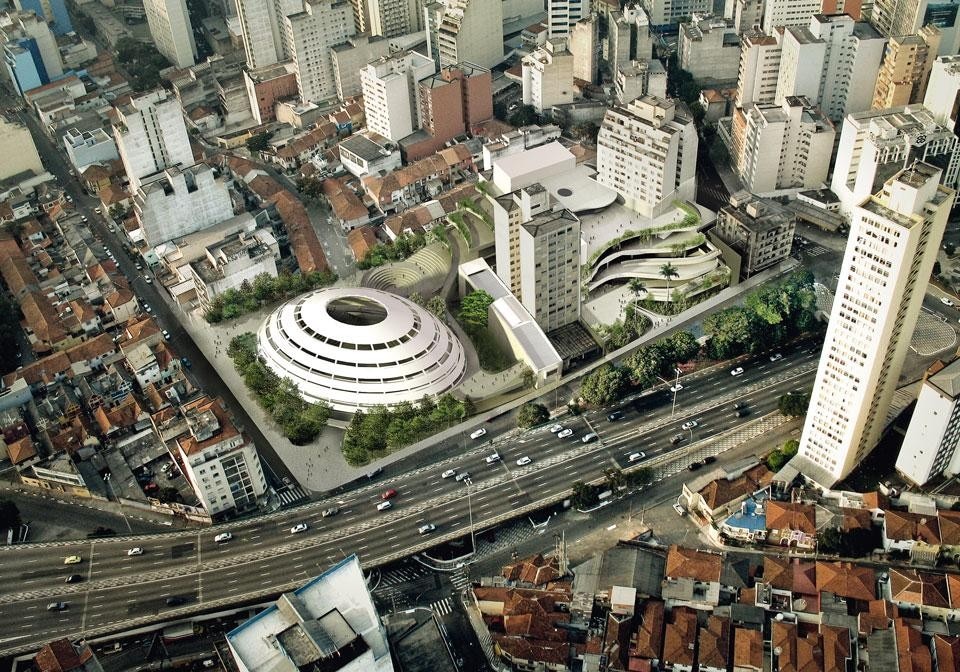
José: The space had become too small. For the performance of Macumba, there were twice as many people in the audience as allowed. Lina's theatre met our needs when it was built. When I returned from exile in 1979, the first thing I did was break through the walls to see what was on the other side. I already noticed that there was this space all around it. I came with an engineer; if there hadn't been any arches, the whole place would have collapsed. We reinforced the seating area and the foundations. It was an emergency job, a stop-gap solution. We weren't allowed to demolish the facade because it was protected by the municipal cultural heritage commission. But Lina forced us to install an iron anvil, because she was Candomblé and said: "If you put an anvil in plain sight, as a kind of symbol, you'll never lose this space."
Domus: Has there always been such an intense relationship between the theatre and architects, who have been very different from each other, such as Guedes, Império, Lina and Paulo Mendes da Rocha?
José: I've always thought of architecture as a performance space. I'm very grateful to the architects. Paulo Mendes was also very important. He started developing the project for the Agora (that's what we call the space we've occupied under the Minhocão expressway) and for the adjacent land. His project was confined to a very small space, so he designed two narrow towers: one for production with a small dormitory for the actors, and the other for our digital archive.
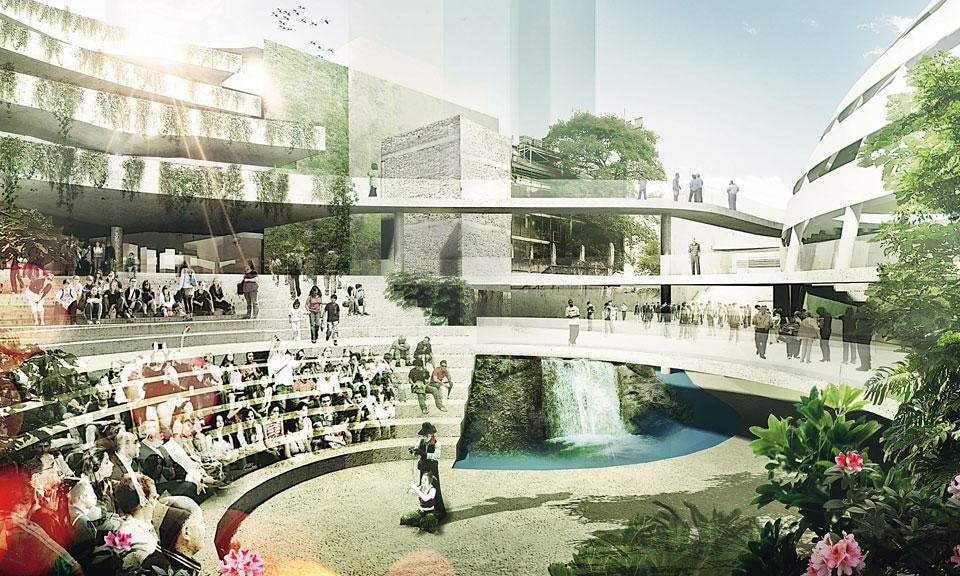
Beatriz Pimenta Corrêa: The idea is to build a stadium on the site next door. The Oficina would act as the Greek skene of the future stadium. The two arenas will have to be integrated with the tree. It's not about ignoring the Oficina, but rather about building something else. In Lina's project, the stadium was supposed to be built at the end of the original building. But when Silvio Santos started stirring up this whole battleground scenario, demolishing everything, we thought we'd enlarge the project. We decided to put the stadium here, the Oficinas das Florestas over there, and the Universidade Antropófaga further up.
José: For all these years, since 1967, we've been producing knowledge based on experience. Through anthropophagy, we have reviewed virtually the entire repertoire of world theatre, the Greeks, Shakespeare, Gorky, Tennessee Williams, Nelson Rodrigues, Brecht. Everything was done with choirs and music, because we wanted to do choral theatre. It's impossible for this direction not to be attributed to Lina Bo Bardi, in the same way that the Teatro de Estádio can only be attributed to Oswald de Andrade. Debris as resources. I see the walls, I see the floor.


